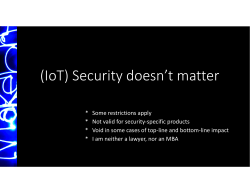
LooCI in the city - DistriNet
LooCI in the city drag & drop software deployment live status monitoring The LooCI software development kit was applied to manage smart office IoT infrastructure at KU Leuven in a secure and energy-efficient way. Secure & energy-aware management of IoT applications Industrial demand for managing the “Internet of Things” (IoT) How to continuously adapt third party IoT applications at smart city scale? Secure and cost-efficient application management of smart IoT infrastructure is crucial to (1) maximize system lifetime and return-on-investment, and (2) control access to battery, processing and memory resources, which are shared between the many co-executing IoT applications. Although IoT management mechanisms exist, these solutions fail to differentiate between multiple (independent) applications and often lack support for fine-grained component updates. The current practice of reloading the complete system image results in high network traffic and a considerable energy penalty; in addition, these solutions impact all running IoT applications because the sensor device must be restarted after the update. This is unacceptable for IoT applications that rely on 24/7 availability (e.g. traffic light control applications, building access control applications, smart metering applications). Traditional IoT infrastructure lacks middleware to manage distribution concerns such as remote application communication, access control and resource management; the LooCI middleware enables secure and energy-efficient micro-updates, i.e. small updates of components and security policies to adapt application behavior to changing operational conditions. LooCI in the city The LooCI software development kit The LooCI software development kit (LooCI: Loosely-coupled Component Infrastructure ) offers developers a coherent solution for programming, deploying and configuring Networked Embedded Systems (NES). LooCI enables: 1. programming wireless Contiki-enabled sensors and actuators, 2. discovering sensor capabilities remotely via an Android device, 3. deploying lightweight security policies on critical sensors and actuators, 4. and dynamically controlling and configuring application components in an energy-efficient way². Key LooCI building blocks include: LooCI models: - component model (for functionality), - policy model (for security or logging), - event model (for communication) LooCI execution environment (Contiki, Android, OSGi): distributed communication, run-time discovery, deployment and reconfiguration LooCI configuration tools: - Eclipse plug-in for contemporary programming of NES - component repository - management dashboard About iMinds-DistriNet iMinds-DistriNet is an international research group with extensive expertise in secure and distributed software, including middleware. Embedded in the department of Computer Science of the KU Leuven, iMindsDistriNet has a headcount of over 75 researchers of which 10 professors and 20 senior researchers. Prof. Danny Hughes coordinates the work on on software technology for network embedded systems. iMindsDistriNet is part of the recently established iMinds Security Department, a de facto “one-stop-shop for ICT security research”. More information on projects and publications can be found at https:// distrinet.cs.kuleuven.be. Contact sam.michiels@cs.kuleuven.be danny.hughes@cs.kuleuven.be Industrial partners @LooCI_DistriNet More Info https://distrinet.cs.kuleuven.be/software/looci/ ² D. Hughes, et al., Energy aware software evolution for wireless sensor networks, IEEE WoWMoM, pp. 1—9, 2013.
© Copyright 2025





















